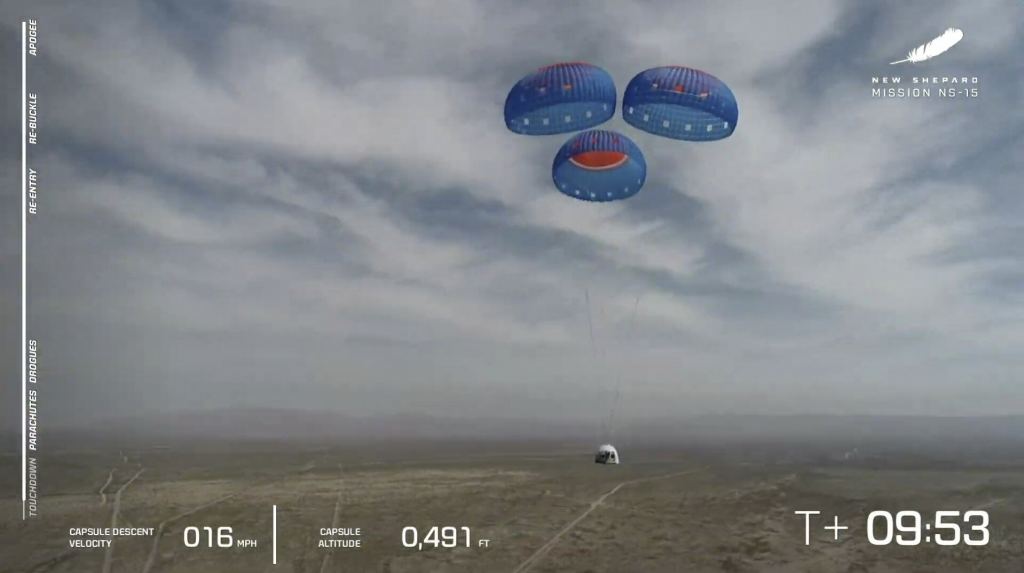In 2000, Amazon founder and CEO Jeff Bezos founded Blue Origin, a commercial space company intended to become one of the crown jewels of his financial empire. Unfortunately, Blue Origin has lost ground in recent years to companies like SpaceX, which have been pushing the envelope with the development of reusable launch systems, resupply services, and human-rated spacecraft.
To address this, Bezos recently stepped down as CEO of Amazon to devote more attention to Blue Origin and other projects. On Wednesday, April 14th, the company hit a milestone when their New Shepard spacecraft (named in honor of famed astronaut Alan Shepard) conducted its fifteenth consecutive mission (NS-15) to space and back. This "crew rehearsal" mission brings Blue Origin one step closer to launching crews and tourists into space.
At the same time, two additional personnel served as the tower operations team and went through their own pre-launch operations. This consisted of preparing the capsule cabin for launch and securing the capsule hatch behind the two astronaut stand-ins once they climbed inside. Once all the pre-launch preparations and checks were complete, the astronauts left the capsule and sealed it shut.
During the flight, which began at At 10:15 A.M. CDT (08:15 A.M. EDT; 11:15 A.M. PDT), the capsule was "crewed" by Mannequin Skywalker (the company's test dummy) and carried over 25,000 postcards from Blue Origin's non-profit group Club for the Future. After the capsule landed, the two astronauts rehearsed post-flight procedures, such as opening the hatch and exiting the capsule.
During the flight, the capsule reached an altitude of 106 km (66 miles), which put it just slightly above the Kármán Line - the official boundary between Earth's atmosphere and "space." About seven minutes after takeoff, the reusable first stage booster made a powered descent and landed upright on the landing pad. Three minutes later, the capsule made a soft landing with its parachutes deployed.
Following the touchdown, the stand-in astronauts went back to the capsule and climbed aboard to practice crew recovery. The entire flight was the subject of a live webcast, which began 60 minutes before launch (posted below). "While there are no astronauts on board today, that was a critical step toward our march toward first human flight," said flight commentator Ariane Cornell, from the company's headquarters in Kent, Washington.
The mission lasted a total of 10 minutes and 10 seconds and achieved a maximum velocity of 3,596 km/h (2,234 mph). It was not only the fifteenth time the New Shepard flew to space, it was the sixteenth consecutive time that the capsule landed successful, which includes a pad escape test in 2012. It is also likely to be Mannequin Skywalker's last spaceflight, as it is being donated to the U.S. Space and Rocket Center.
By testing crew procedures, they are one step closer to clearing the New Shepard for crewed flights, which will include flying paying customers on short hops to space. During these flights, crews of six will experience three minutes of weightlessness and will be treated to breathtaking views of Earth from orbit. Overall, the mission was in keeping with the incremental approach Bezos had in mind when he launched Blue Origin.
Meanwhile, the company is making progress on its New Glenn heavy launch system. Like the *New Shepard*, this two-stage vehicle is named in honor of a pioneering astronaut and member of the " Mercury Seven " - John Glenn. Whereas Shepard was the first American astronaut to go to space - reaching a suborbital altitude of 187 km (116 mi) - Glenn was the first American astronaut to orbit the Earth.
Recent milestones in the development of the New Glenn* include the completion of its first stage mockup simulator, a structural test facility, and the development of hardware elements (tanks, stage modules, and composite fairings). The maiden flight of the New Glenn* is currently targeted for late 2022 and will take place from Cape Canaveral's history Launch Complex 36 (LC-36), which is in the final stages of being rebuilt.
The company's slogan, *Gradatim Ferociter* (in Latin), literally translates to "Step by Step, Ferociously." In this respect, the NS-15 mission and other recent developments are further steps along the road towards fulfilling the dream of space tourism and commercial launches - the very dream the company was founded on. In the meantime, check out the full coverage of the SN-15 launch, courtest of Blue Origin:
*Further Reading: Blue Origin, Phys.org*
 Universe Today
Universe Today


